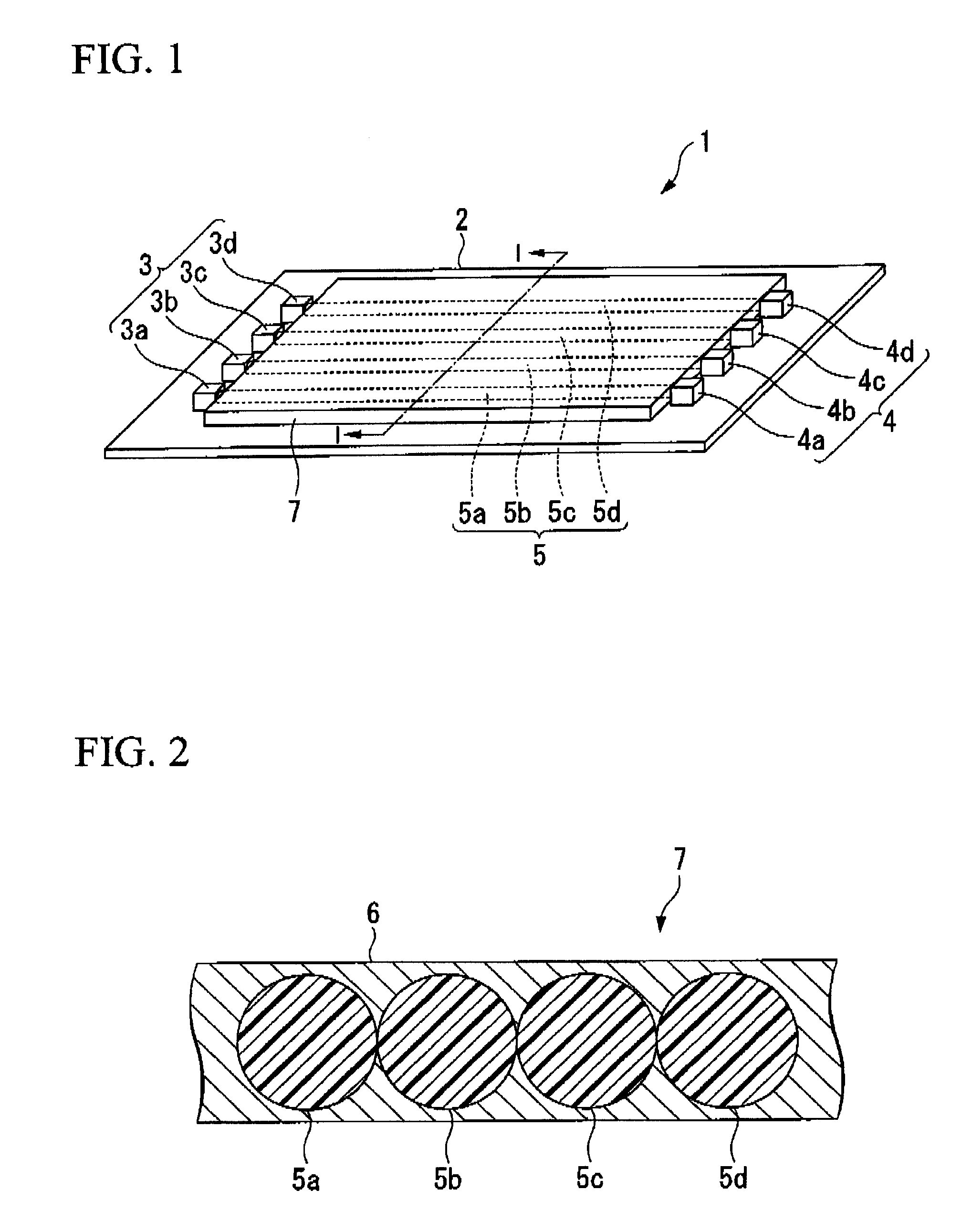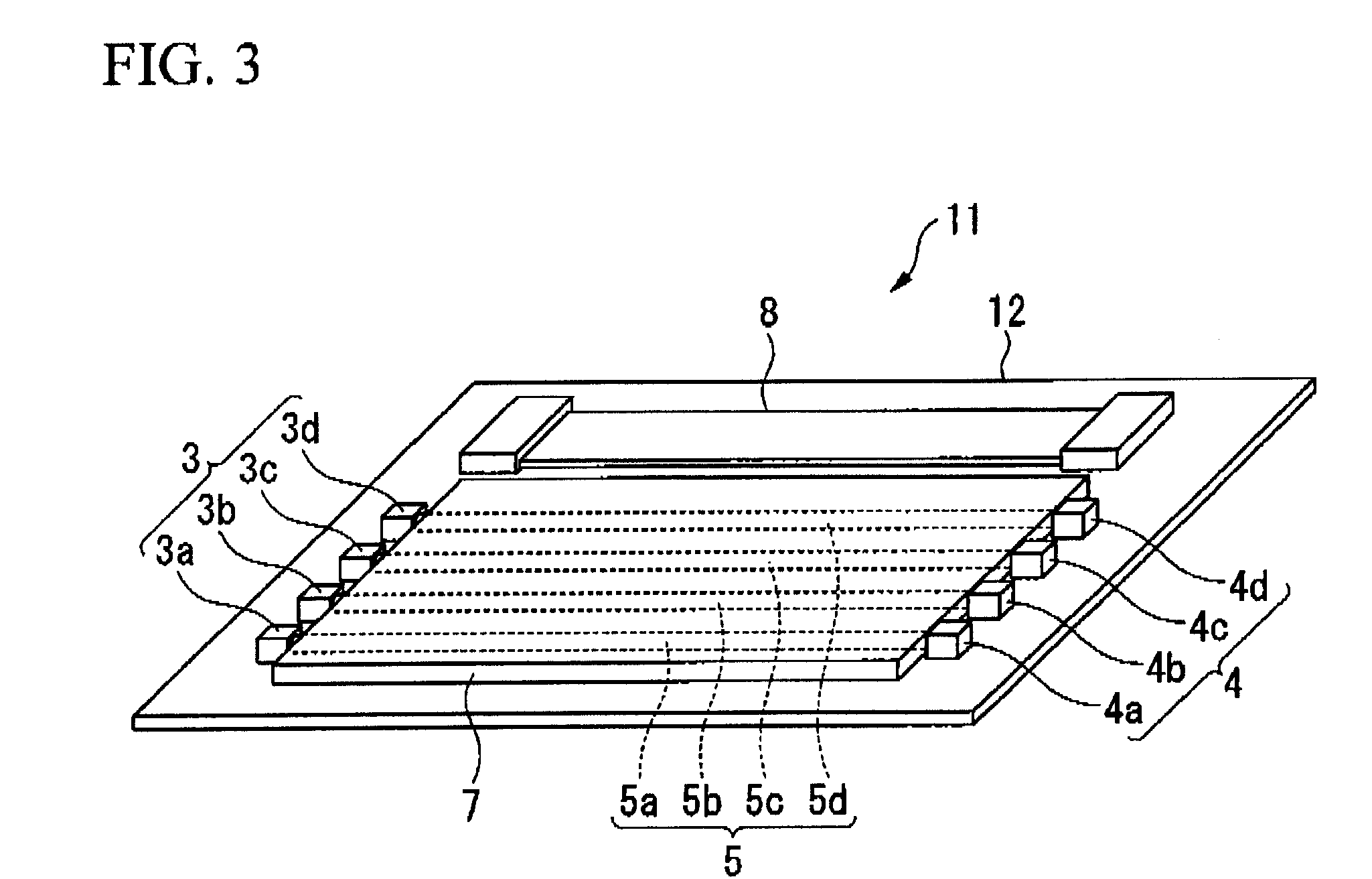Optical/electrical circuit interconnect board and evaluation method therefor
a technology of optical/electrical circuits and interconnect boards, applied in the direction of optical elements, optical waveguide light guides, instruments, etc., can solve the problems of increasing packaging areas or manufacturing costs, noise or signal delay, and more and more, so as to improve alignment accuracy, reduce cost, and facilitate mounting
- Summary
- Abstract
- Description
- Claims
- Application Information
AI Technical Summary
Benefits of technology
Problems solved by technology
Method used
Image
Examples
example 1
[0116] Next, to confirm that plastic optical fibers in the plastic optical tape are required to be arranged in straight lines, a planarity of the case as shown in FIG. 7B was evaluated where, in an optical fiber tape 7 with four plastic optical fibers 5a, 5b, 5c, 5d arranged in parallel with one another, one fiber 5b of the inner two plastic optical fibers 5b, 5c is upwardly displaced and the other fiber 5c is downwardly displaced. The planarity was obtained as a maximum value among distances from a line (hereinafter, referred to as reference line) 10 connecting the outer circumferences of the two plastic optical fibers 5a, 5d, at both ends of the optical fiber tape 7 to the outer circumferences of the plastic optical fibers 5b, 5c. Note that the plastic optical fibers 5 have a length of 1000 mm.
[0117] Light receiving intensity at light receiving elements was evaluated at planarities of 10 μm, 30 μm, 50 μm, and 100 μm. The results are shown in Table 1.
TABLE 1Light Intensity [dBm]...
example 2
[0120] Next, to confirm that replacing one or more of the plastic optical fibers in the optical fiber tape with the reinforcing wire member(s) can improve a planarity with good repeatability, four optical fiber tapes 57A, 57B, 57C, 57D, as shown in FIGS. 12 to 15 were manufactured. In the optical fiber tapes 57A, 57B, 57C, 57D, six plastic optical fibers are arranged in parallel with one another, and reinforcing wire members are located such that the number of adjacent plastic optical fibers is four, three, two, and one, respectively.
[0121] That is, in FIG. 11, outermost plastic optical fibers are relocated by reinforcing wire members 9a, 9b, respectively such that four optical fibers are adjacent to each other. In FIG. 12, an outermost plastic optical fiber at one end and a second outermost plastic optical fiber at the other end are relocated by reinforcing wire members 9a, 9b such that three plastic optical fibers are adjacent to each other. In FIG. 13, an outermost plastic optic...
example 3
[0125] Next, to confirm that when applied to a movable portion, an optical fiber tape with a reinforcing wire member comes to have strong resistance to repetitive bending or twisting by accurately adjusting the wire diameter (outer diameter) of the reinforcing wire member, an optical fiber tape 67 as shown in FIG. 15 was manufactured as follows: two glass optical fibers 69a, 69b were formed by previously coating a second coat material 65 on the outer circumferences of glass optical fibers 69 with a diameter of 125 μm as reinforcing wire members to make the outer diameter thereof equal to the wire diameter of plastic optical fibers 5 with a diameter of 500 μm; the glass optical fibers 69a, 69b were adjacently arranged in parallel to each other; plastic optical fibers 5a, 5b were located on the outer sides of the glass optical fibers 69a, 69b, one for each side; and these four fibers were brought together side-by-side and were coated with a first coating material 6.
[0126] The optical...
PUM
 Login to View More
Login to View More Abstract
Description
Claims
Application Information
 Login to View More
Login to View More - R&D
- Intellectual Property
- Life Sciences
- Materials
- Tech Scout
- Unparalleled Data Quality
- Higher Quality Content
- 60% Fewer Hallucinations
Browse by: Latest US Patents, China's latest patents, Technical Efficacy Thesaurus, Application Domain, Technology Topic, Popular Technical Reports.
© 2025 PatSnap. All rights reserved.Legal|Privacy policy|Modern Slavery Act Transparency Statement|Sitemap|About US| Contact US: help@patsnap.com



